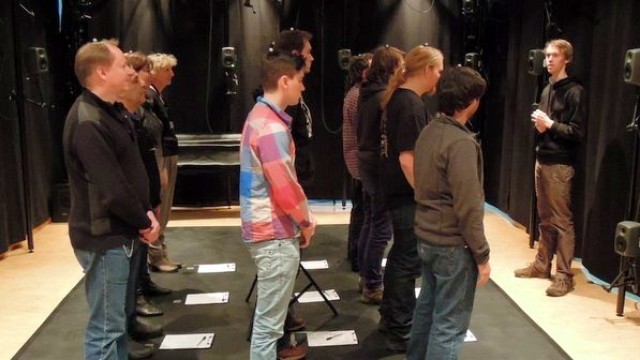
The datasets included in this database have been collected in several different research projects, and using three different experimental paradigms:
Championship of Standstill data

This is the largest dataset and contains head-marker motion capture data from around 70-100 participants for each edition. The task was to stand as still as possible in groups of people (3-11) in a competitive setting. There were slight variations each year, with different types of music being played to the participants.
Headphones-Speakers data

This dataset contains full-body motion capture data as well as physiological measurements for a total of 34 participants. The data was collected individually, and people were asked to stand and listen to different types of rhythms and rhythmic music with both headphones and speakers.
Sverm data

This a longitudinal dataset and contains head-marker motion capture data for 2-5 people standing still multiple times over several years. The task differed slightly, looking at how sound, music, and various types of mental tasks would affect the standstill sessions.
The three datasets are different, but they are all focused on people standing still on the floor. They are recorded in the same lab and with (almost) the same equipment. Only anonymized motion capture data is made available.
The Data
Please find all the datasets below. We have tried to make the data as accessible as possible, but you will need to invest some time to get anything meaningful out of them. If you are only interested in getting a glimpse of what the data looks like, you should go to the web pages. They contain ready-made plots and descriptions. The Jupyter notebooks show how it is possible to analyse the data with Python. Even if you don't know Python, you may get something out of looking at the ready-made plots. We provide some Matlab code as well, but this is in general not as complete as the Jupyter Notebooks. The complete datasets are available from Physionet, where you can also find detailed descriptions of all the content. The datasets have also been deposited with the Norwegian Data Centre NSD.
| Championship 2012 | Web | Stimuli | Jupyter | Matlab | Physionet | NSD |
| Championship 2015 | Web | Stimuli | Jupyter | Matlab | Physionet | NSD |
| Championship 2017 | Web | Stimuli | Jupyter | Matlab | NSD | |
| Championship 2018 | Web | Stimuli | Jupyter | Matlab | NSD | |
| Championship 2019 | Web | Stimuli | Jupyter | NSD | ||
| Headphones-speakers | Web | Stimuli | Jupyter | Matlab | NSD | |
| Sverm | Web |
License
![]() The data is made available with a CC-BY license.
The data is made available with a CC-BY license.
Cite the database
There are not yet any publications describing the database. You can cite the database like this:
- Jensenius, A.R. (2020). Oslo Standstill Database. University of Oslo
Or you can find proper citations (with DOIs) to each of the archived datasets (from Physionet or NSD).
Publications
The datasets above have been used in several publications:
- Zelechowska, Agata; Gonzalez Sanchez, Victor Evaristo; Laeng, Bruno; Vuoskoski, Jonna Katariina & Jensenius, Alexander Refsum (2020). Who Moves to Music? Empathic Concern Predicts Spontaneous Movement Responses to Rhythm and Music. Music & Science.
- Zelechowska, Agata; Gonzalez Sanchez, Victor Evaristo & Jensenius, Alexander Refsum (2020). Standstill to the ‘beat’: Differences in involuntary movement responses to simple and complex rhythms, In AM '20: Proceedings of the 15th International Conference on Audio Mostly. Association for Computing Machinery (ACM).
- Zelechowska, Agata; Gonzalez-Sanchez, Victor E.; Laeng, Bruno & Jensenius, Alexander Refsum (2020). Headphones or Speakers? An Exploratory Study of Their Effects on Spontaneous Body Movement to Rhythmic Music. Frontiers in Psychology. 11(698)
- Gonzalez Sanchez, Victor Evaristo; Zelechowska, Agata & Jensenius, Alexander Refsum (2019). Analysis of the Movement-Inducing Effects of Music through the Fractality of Head Sway during Standstill. Journal of Motor Behavior.
- Gonzalez Sanchez, Victor Evaristo; Zelechowska, Agata & Jensenius, Alexander Refsum (2018). Correspondences Between Music and Involuntary Human Micromotion During Standstill. Frontiers in Psychology.
- Jensenius, Alexander Refsum (2017). Exploring music-related micromotion, In Clemens Wöllner (ed.), Body, Sound and Space in Music and Beyond: Multimodal Explorations. Routledge.
- Jensenius, Alexander Refsum; Zelechowska, Agata & Gonzalez Sanchez, Victor Evaristo (2017). The Musical Influence on People's Micromotion when Standing Still in Groups, In Tapio Lokki; Jukka Pätynen & Vesa Välimäki (ed.), Proceedings of the 14th Sound and Music Computing Conference 2017. Aalto University
- Jensenius, Alexander Refsum (2015). Microinteraction in Music/Dance Performance, In Edgar Berdahl (ed.), Proceedings of the International Conference on New Interfaces For Musical Expression. Louisiana State University.
- Jensenius, Alexander Refsum; Bjerkestrand, Kari & Johnson, Victoria Kristine Å (2014). How still is still? Exploring human standstill for artistic applications. International Journal of Arts and Technology. 7(2/3), s 207- 222
- Jensenius, Alexander Refsum & Bjerkestrand, Kari Anne Vadstensvik (2012). Exploring micromovements with motion capture and sonification, In Anthony Brooks (ed.), Arts and Technology, Second International Conference, ArtsIT 2011, Esbjerg, Denmark, December 7-8, 2011, Revised Selected Papers. Springer.